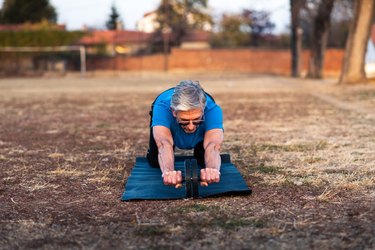
Doing a core workout for a 50-year-old man doesn't necessarily have to look different from the core workout for a man of any age — but it is arguably more important. As you age, core strength plays an important role in preserving your athletic performance and decreasing fall risk.
As noted in a systematic review published in the July 2013 issue of Sports Medicine, trunk muscle strength — another way of saying core strength — correlates with better balance, functional performance and lower risk of falls in older adults. Although it's challenging to peg a single best ab workout for men over 50, the best exercises will minimize stress on a back that's been subject to wear and tear already, while still preserving that all-important core strength.
Video of the Day
Video of the Day
Read more: The 41 Hardest Ab Exercises
Ab Exercises for Men Over 50
You won't find a more qualified expert on core training than Dr. Stuart McGill, aka "Dr. Spine," professor emeritus of 32 years at the University of Waterloo Spine Biomechanics Laboratory. In a 2009 video shared by the University of Waterloo, which has well stood the test of time, he recommends the following four core exercises to protect your spine while still allowing you to train like an athlete.
Move 1: Crunch Alternative
- Lie flat on your back, knees bent and feet flat on the floor.
- Tuck your hands under the curve of your lumbar spine to support it.
- Extend one leg straight out, squeezing your core muscles to keep your back from arching.
- As Dr. McGill directs, imagine that your head and shoulders are on a bathroom scale. Squeeze your core muscles and lift your head and shoulders just enough to unweight the imaginary scale. Then gently lower your head and shoulders back to the mat.
Move 2: Stir the Pot
- Assume a plank position on a stability ball. Your legs should be extended straight behind you, toes on the floor, with your arms bent and forearms resting on the ball. Clasp your hands together for extra stability.
- Check your body position — your body should be in a straight line from shoulders to heels.
- Squeeze your core muscles to maintain that stable body position as you "stir the pot," rotating your elbows and clasped hands in a small circle to one side.
- Make sure to "stir the pot" in the other direction as well.
Move 3: Side Bridge
- Assume a side plank position, with the bottom-most arm bent, elbow directly beneath your lower shoulder, forearm resting on the ground to help with balance. Straighten your legs and let your uppermost foot slide slightly forward of the other for better stability.
- Check your bottom position: Your hips and shoulders should be stacked one over the other, spine straight (not piked) so that from an onlooker's perspective you're facing squarely to the side — not angled up or down.
- Squeeze your abs to maintain this body position. Dr. McGill recommends placing your upper hand on the lower shoulder and pulling the elbow of that upper arm closer to your body; he says it's easier on your shoulder.
Move 4: Bird Dog
- Position yourself on the floor, on your hands and knees.
- Squeeze your core muscles to keep your back stable as you lift your right arm up and forward, while your opposing (left) leg lifts up and back. Try to keep your back from flexing, extending or tilting to one side.
- Dr. McGill recommends holding this position for 10 seconds, then bringing your arm and leg back to their original position — just brushing against the floor — before extending them back out to the lifted position.
- Make sure to work the other side as well.
Tip
How many repetitions should you do? In its recommendations for core strength exercises, the Mayo Clinic recommends working up to 10 to 15 repetitions. Once you can consistently do 15 repetitions with good form, you can consider doing a harder variation of that exercise.
Warning
It's always best to consult a physician before beginning any new exercise program — especially if you have back problems or other conditions that might affect your ability to safely do core exercises.